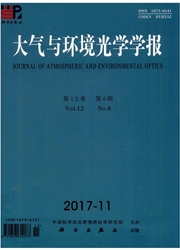

 中文摘要:
中文摘要:
离子诱导成核是大气气溶胶形成的重要路径之一。大气中团簇离子的形成,主要由宇宙射线电离空气产生的初级离子与H2O、H2SO4、HNO3、NH3、有机物等物质发生的离子-分子反应而产生。成核是团簇离子生长和蒸发相互竞争的一个过程,团簇离子生长到临界核尺寸时,便可自发生长。研究表明临界核大小约1.6 nm,对应粒子的质量数在5000 amu以上。离子诱导生成的气溶胶粒子对气候的影响以及离子诱导成核在大气成核事件中是否占主要作用还存在很大争议,这需要进行进一步的外场观察、理论模拟、实验室研究来充分弄清离子诱导成核机理。
 英文摘要:
英文摘要:
Ion-induced nucleation is one of the most significant pathway of aerosol particle formation in the atmosphere.Air molecules are radiated by the cosmic ray to generate a mass of initial primary ions which will quickly react with common trace air constituents,such as H2O,H2SO4,HNO3,NH3 and organic species to form more stable ions,called as cluster ions.Processes for aerosol formation are the competition between growth and evaporation.When the critical nucleus forms,the formed small aerosol particle growth become spontaneous.This critical diameter can be calculated and predicted to be about 1.6 nm with mass number more than 5000 amu at standard atmospheric condition.However,there exist many controversies on ion-induced nucleation to what extent of influencing global climate and new particle nucleation.More observations,molding and laboratory studies should be carried out to explore the mechanism of ion-induced nucleation clearly.
 同期刊论文项目
同期刊论文项目
 同项目期刊论文
同项目期刊论文
 期刊信息
期刊信息
